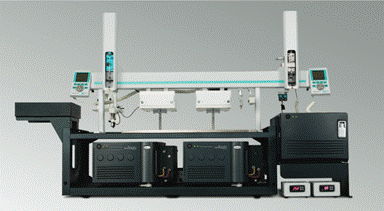Instrumentation: Hydrogen Deuterium Exchange with Mass Spec (HDX MS)
THE SYSTEM:
The unprecedented system-level design integrates all the steps necessary to accurately, reproducibly – and most of all, easily – perform protein conformation studies. The Waters UPLC HDX MS system removes the barriers to adopting high resolution LC and MS for routine studies of protein conformational changes, making HDX a core competency for your laboratory.
ACQUITY UPLC® with HDX Technology

A core element of the system is the HDX Manager, which is purpose-built to manage samples separated under higher operating pressures, at 0° C and with no compromise in deuterium recovery. Its improved chromamatographic resolution is paired with a state-of-the-art mass spectrometer such as the Xevo® G2-S QTof or SYNAPT® G2-Si HDMS systems. The system also integrates on-line proteolysis with trapping capability and MSE technology for maximum sequence coverage of complex mixtures of peptic digest.
Enzymate™ Online Digestion Column
An immobilized pepsin column packed with mechanically strong BEH particles, the Enzymate BEH Pepsin Column (2.1 x 30 mm, 5 µm) is capable of operating at 15,000 psi, whose digestion efficiency is enhanced at both low and high digestion pressures.
Mass Spectrometry: Waters SYNAPT G2-S
The SYNAPT G2-S incorporates both high-sensitivity Waters StepWave™ ion transfer optics and Triwave® ion mobility technologies along with a suite of new informatics tools to take qualitative and quantitative high resolution performance to a new level. SYNAPT G2-S provides a 30X improvement in signal intensity for mass spectral peaks, better than a 5X improvement in signal-to-noise, and up to a 10-fold improvement in limits of quantitation over previous-generation mass spectrometers. The significant increase in sensitivity, together with the unrivalled selectivity and analytical peak capacity made possible by ion mobility separations, allows the SYNAPT G2-S to identify and quantify sample analytes at lower concentrations than any other high resolution mass spectrometer and easily and routinely reveal details about complex samples that were previously difficult or impossible to obtain.
DynamX Data Analysis Software v 3.0
In HDX studies, data are produced across multiple time points, multiple species, and with replicates. Curating this data manually is not time-efficient and requires expert interpretation. Interpretation of this data is a repetitive process that requires counting and measuring spectra. DynamX Software is designed to systematically select spectra with predetermined criteria and measure the mass change of the deuterated form. The software automation was greatly simplified by utilizing the sharper peaks and better separation available with UPLC, and the comprehensive nature of the MSE detection. This automation, along with the capability to sort and display data, has been an important advance. DynamX tracks all peptides that are reproducibly found in replicates, ensuring consistency in monitoring the deuterium exchange. The software also calculates the amount of deuteration and displays the results in convenient comparative views: uptake curves, a butterfly chart, and a difference chart. Data processing time is significantly reduced from months for manual processing to hours for automated processing.
DynamX software helps researchers assess possible conformational changes in their proteins quickly. It simplifies hydrogen-deuterium exchange interpretation by performing these tasks:
Aggregates search results from ProteinLynx Global SERVER™ (PLGS) to generate a list of peptides for interrogation during the experiment.
Processes mass spectrometer data files to search for ions belonging to each peptide.
Determines deuterium uptake automatically.
Aggregates data as a function of replication and experimental state.
Visualizes data for easier interpretation.
Allows interaction with data; easily navigate data and modify results if necessary.